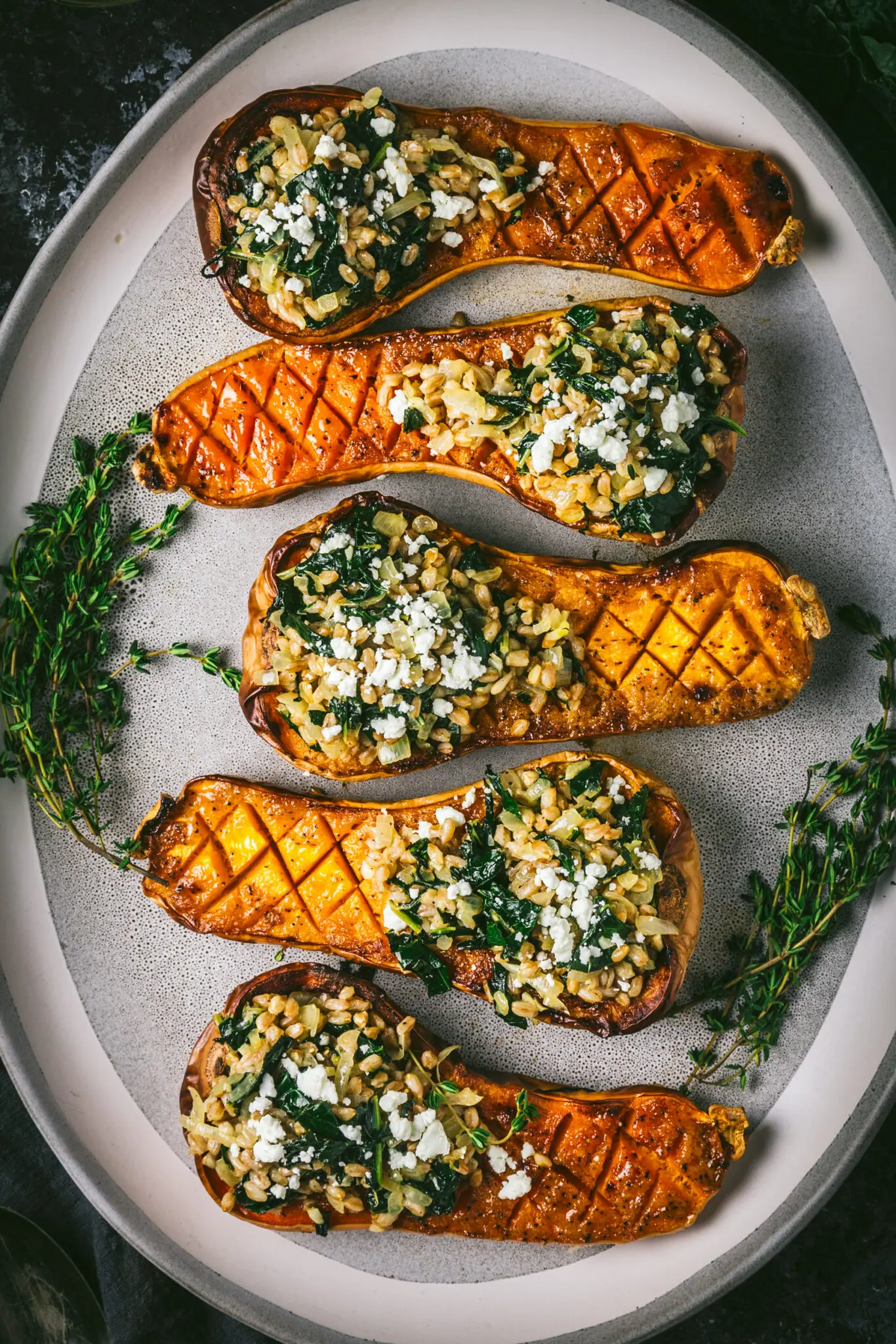
Why do winter-season dinners feel more of a challenge to put together than summer ones? The days are darker, the evenings draw in, there isn’t quite as much fresh local produce at the store or farmer’s market, and maybe we don’t have the energy to get as creative as we’d like. But here’s the key: sticking with simple ingredients such as hardy winter squash, healthy farro and fresh greens, and then packing them with winning flavor combinations will reward you with a dinner as healthy and delicious as it is straightforward.
In this recipe, we’ve partnered with Maille Dijon Originale Mustard to create a hearty seasonal winter supper packed with nutrition and flavor.
A recipe, at its heart, is a combination of ingredients — and some combinations are simply classic. We’ve written before about the magic of combining farro and kale — Stir Fried Farro with Garlicky Kale and Poached Egg and Farro Salad with Roasted Grapes and Baby Kale and we’ve even combined both with butternut squash in Farro Salad with Butternut Squash, Pistachios and Parmesan. These are the foods we crave when the winter light struggles to get up off the horizon and our vitamin levels need a serious boost. As food writers, we do what we can to avoid using cliches, but honestly, the phrase “nutritional powerhouse” might have been invented for these three ingredients.
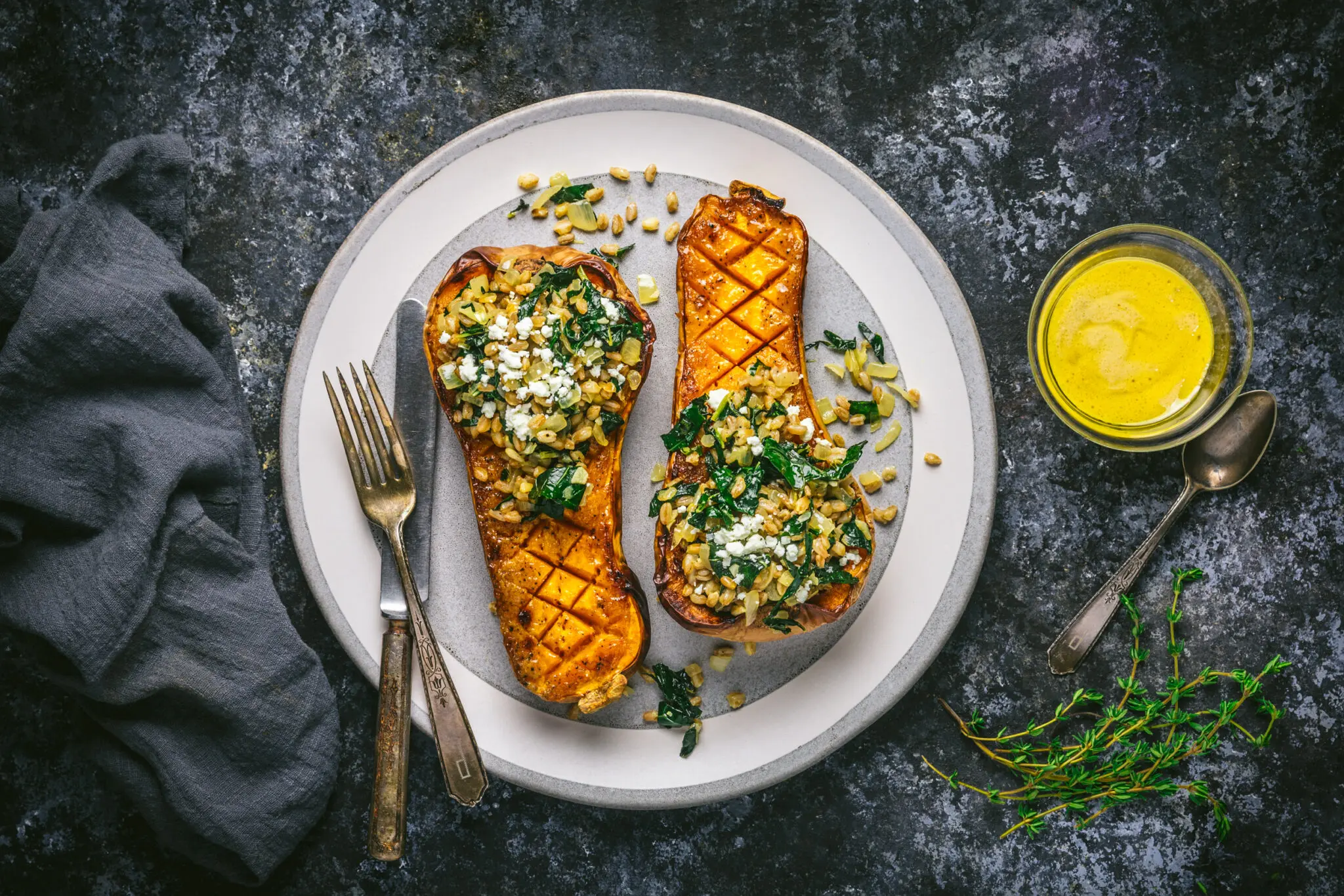
The other classic flavor combination here is mustard and maple syrup. We use this pairing all the time, as a marinade or cooking sauce (and often, both at the same time): see, for example, Maple-Mustard Baked Chicken Thighs and Brown Sugar and Mustard Glazed Acorn Squash (where we often substitute maple syrup for the brown sugar). In fact, we’ve used mustard twice in this recipe: both as a glaze to roast the squash, and as a vinaigrette-style dressing for the cooked farro and greens. This gives the dish an unmistakeable tangy bite that we love.
We’ve used small butternut squash for this recipe — it roasts easily, has a natural sweetness and turns a gorgeous amber color when cooked. In recent years, a new variety called honeynut has been developed by Cornell University plant breeder Michael Mazourek and chef Dan Barber — it’s quite a bit smaller than a regular butternut, and has sweeter, darker flesh. We love honeynut squash and recommend you look out for it in local fall harvests — but unlike butternut, you probably won’t be able to find it year-round. In fact, you can use any winter squash variety you like, whether it’s acorn, butternut, honeynut or delicata. Butternuts can range widely in size so look for smaller ones that weigh about a pound or so. Scoring the flesh helps the glaze sink into the squash, infusing it with flavor.

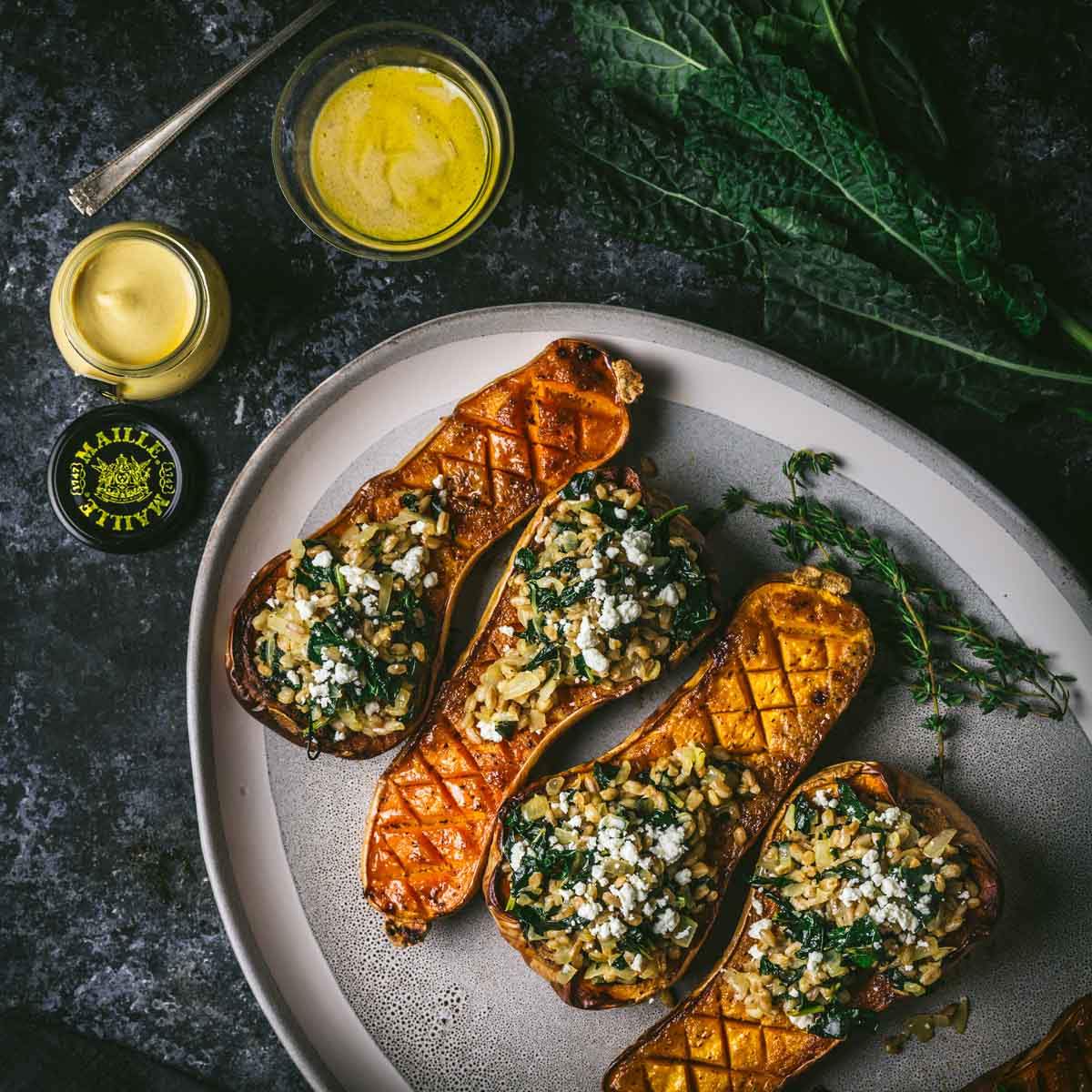
When we stuff any winter squash, we like to make sure that the squash itself is packed with flavor. A tasty stuffing is great and all, but if the squash itself is bland the final dish will be disappointing. That’s why we brush the squash with a glaze made with maple syrup and our favorite Maille Dijon Originale Mustard, which infuses the flesh of the squash with smoky, sweet, spicy flavor. Butter adds a little richness (though olive oil is fine too). The stuffing has loads of flavor too, of course, with caramelized onions, fresh thyme, and a serious amount of garlic. We’re not talking one clove. We’re not even talking two cloves. We’re talking three actual cloves — and let us tell you, if a recipe calls for just one clove of garlic, feel free to turn up your nose: pun intended. (The sautéed garlic turns mild and sweet, though. The only time we add one clove is if we’re making a dip, such as hummus, with raw garlic — otherwise, the more the merrier.)
Note: don’t worry if there is a little liquid in the bowls after roasting. The filling will soak it up and get even more delicious.
While the squash is roasting, you can make the filling. We love farro because it has a wonderful toothsome texture, as well as great flavor, but any grain will work well here (quinoa, millet, barley or a wild rice would be fine options). You can make the grain up to a day or two ahead so it’s a great use of leftovers if you’ve already cooked up farro for another recipe.
You can also use any hearty greens you like. We love Lacinato kale (also called dinosaur kale) but regular curly kale, chard, mustard greens or spinach would be great too.
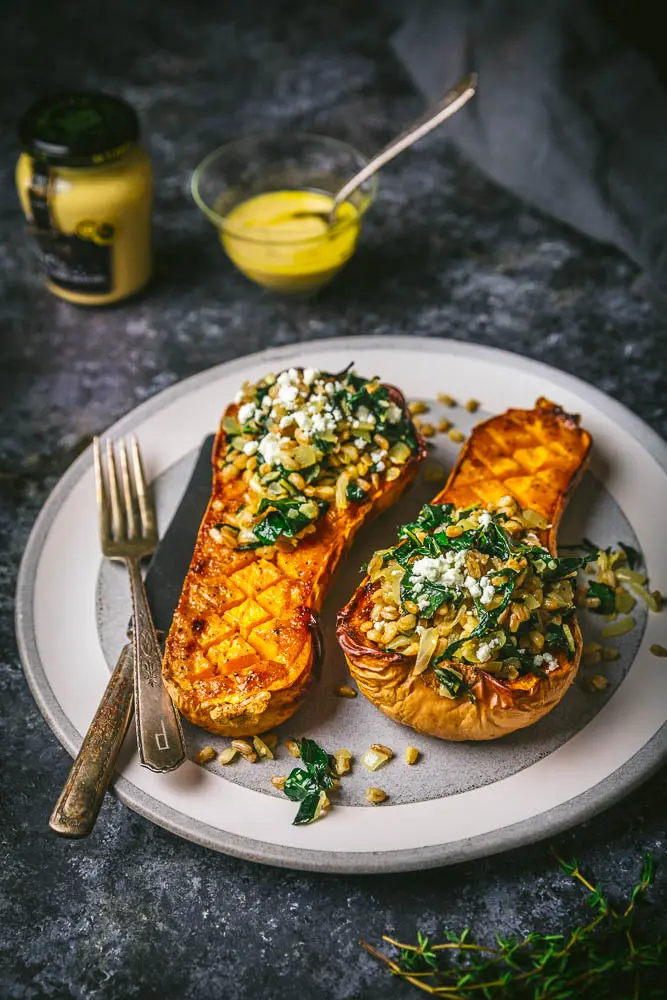
The process is extremely simple: brush the glaze on the squash flesh and roast until they turn tender and sweet. Sauté the onions, garlic and kale, add a little white wine (or broth) and stir in the farro. Once the squash is ready, fill the bowls with the stuffing, sprinkle over a little goat cheese (which is totally optional. Leave it off if you want to keep it vegan) and bake it again just until it’s all hot.
And there you have it! A vegetarian winter supper, packed with all the healthy things, and flavored with an infusion of sweet and spicy with the help of Maille Dijon Originale Mustard. This is on regular rotation on our menu until Spring!
Mustard and Maple-Glazed Butternut Squash stuffed with Farro and Winter Greens
Ingredients
- 3 small butternut squash or 4 honeynut, halved lengthwise, seeds discarded
For the glaze
- 1 1/2 tablespoons unsalted butter melted (or olive oil)
- 1 1/2 tablespoons maple syrup
- About a tablespoon of whole grain mustard
- 1/2 teaspoon kosher salt
- 1/4 teaspoon freshly cracked black pepper
For the filling
- 2 tablespoons extra virgin olive oil divided
- 1 large yellow onion finely diced (about 1 1/2 cups)
- Kosher salt and freshly cracked black pepper to taste
- 3 garlic cloves minced
- 2 teaspoons minced fresh thyme leaves
- 3 cups about 1/2 pound winter greens, roughly chopped (you could use kale, chard, mustard greens, or spinach)
- 1/2 cup white wine or dry vermouth or stock
- 2 1/2 cups cooked farro see note below
- 1 tablespoon white wine vinegar
- 1 tablespoon whole grain mustard
- 3 ounces goat cheese optional
Instructions
- Preheat the oven to 425ºF and set a rack in the middle. Line a large baking sheet with parchment paper or foil.
- Using a sharp paring knife, score the flesh of the squash in diagonal cuts, about an inch apart, in both directions. Be careful not to cut through the skin.
- In a small bowl, mix together the butter, maple syrup, mustard, salt and pepper.
- Place the squash halves, cut side up, on the baking sheet and spread the glaze over the flesh of each squash. Roast until tender, 25-30 minutes for honeynut squash, or 40-45 minutes for small butternut squash. It should be quite soft all over when pricked with a fork.
- While the squash bakes, make the filling. Set a large skillet over medium-high heat and add the oil. Add the onion and season with salt and pepper, to taste. Cook, stirring occasionally, until the onion start to softens, about 4 minutes. Add the garlic and thyme and cook for about a minute longer. Add in the kale and wine (or stock), and cook, stirring, until the greens are wilted and tender, about 5 minutes (if using spinach, this will take less than a minute). Toss in the farro, mix it to combine with the vegetables, and cook until hot, about 2 minutes. Stir in the vinegar and mustard, and season with salt and pepper to taste.
- When the squash is soft and brown, remove from the oven. Let them sit for a few minutes to re-absorb the glaze. If there is still a lot of liquid in the squash bowls, you can spoon it out and mix it into the cooked farro.
- Lower the oven temperature to 375ºF or use a broiler. Stuff the farro mixture into the bowls of the squash, heaping it, as needed – we were able to fit about 1/4 cup in ours. You can serve any extra filling on the side. Top with crumbled goat cheese and bake or broil until everything is piping hot and the cheese browns a little. Serve hot or at room temperature.
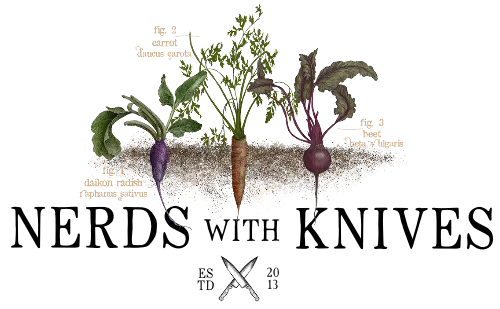
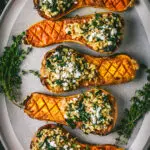
What a wonderful, tasty dish!